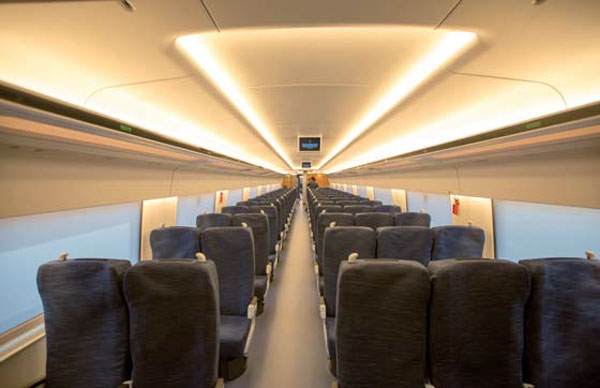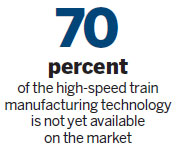A vital link in high-speed growth
Updated: 2015-08-28 08:30
By Cecily Liu(China Daily Europe)
|
|||||||||||
|
Inside a Chinese high-speed train. |
China's high-speed train technology started to develop in 2004, initially through studying the technology of high-speed trains in Japan, France and Germany, and then engaging in self-initiated R&D.
This development followed the strategic direction proposed by China's State Council, which proposed introducing advanced technology, combining design and production, to create a Chinese brand.
One key advantage of the Chinese high-speed trains system is its adaptability to different climates and environments, because China's varied landscape has forced firms like CRRC to produce resilient products.
For example, CRRC trains can run in all landscapes, including plain, mountain, alpine, plateau and sandy areas. They can withstand hot climates of 40 to 45 C, but simultaneously function perfectly in a temperature of minus -40 to -45 C.
CRRC's high-speed trains have also broken world records on several occasions, for example, the 2,298-km Beijing-Guangzhou line is the longest in the world. CRRC has also recorded the largest delivery quantities of high-speed trains globally, having delivered 950 high-speed trains as of April.
Russell Jackson, market director of emerging markets, transportation, at engineering consultancy Atkins, says the costs per kilometer of Chinese high-speed railways are very competitive when compared with the UK.
"I expect the technology is comparable to the UK, as it's clear the Chinese rail industry has built a vast high-speed network in the time the UK has spent between building HS1 and designing HS2 - that is an unrivalled experience and capability in high-speed railway engineering.
"However, it is important for Chinese railway firms to understand the differences between Chinese and UK environments when looking to bring their experience to benefit UK projects," Jackson says.
"The UK's challenges are around building the line in urban and semi-urban environments, and in rural areas where the public hold environmental protection as a tough balance against the new railway's benefits."
Qiu Yi, an associate professor at the University of Southampton who focuses on sound and vibration research for public transport, says Chinese high-speed trains are on a par with global standards for their hardware, but still lag behind overseas competitors for some software such as safety and comfort levels.
"After all, the main leading high-speed train companies globally all have the sufficient technology for the trains to achieve the desired functions, safety and comfort are the next level of competition," says Qiu. "This is especially the case in Europe as comfort and customer experience are seen as so important in Europe's transport industry."
Because of the fast growth of China's high-speed train industry, and the demand for high-quantity systems, Chinese companies have not historically placed much focus on comfort in relation to vibration and noise, but this situation is now changing as passengers demand more comfort.
To help CRRC improve its train comfort, the Institute of Sound and Vibration Research at the University of Southampton started two cooperation projects with the CRRC team last year, one focusing on active noise control and the other focusing on sound quality.
Active noise control is a technology that reduces unwanted sound by the addition of a second-sound specifically designed to cancel the noise. Sound quality technology assesses the accuracy, enjoyability or intelligibility of audio output or sound using both objective and subjective methods.
Qiu says although some of this technology has been applied in the West in the car and aviation industries, it has not yet been applied to the high-speed train industry, and cooperation with CRRC can help them take a lead.
Now that the University of Southampton has become a part of the CRRC research center in the UK, Qiu's team is currently working with CRRC to set up a collaborative research project on active noise control seat and ride comfort.
Today's Top News
Xi's trip to herald 'golden decade' for relations
Wanda's chairman Wang again becomes richest Chinese
Ex-NBA star Odom reported critical, Kardashian at his side
Country house to add English tradition to Xi, Cameron meeting
Most Chinese cities failing air quality standards: Report
Xi to initiate 'golden era' in China-UK ties
China's September inflation cooler than expected
Sensible strategic move by Russia to give Assad support
Hot Topics
Lunar probe , China growth forecasts, Emission rules get tougher, China seen through 'colored lens', International board,
Editor's Picks

|

|

|

|

|

|








